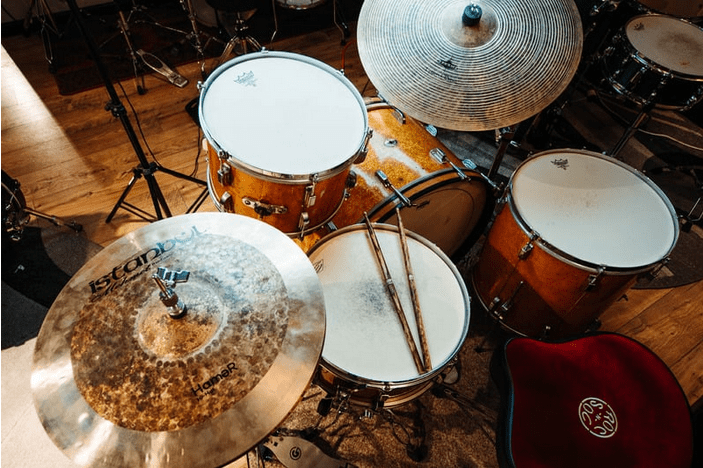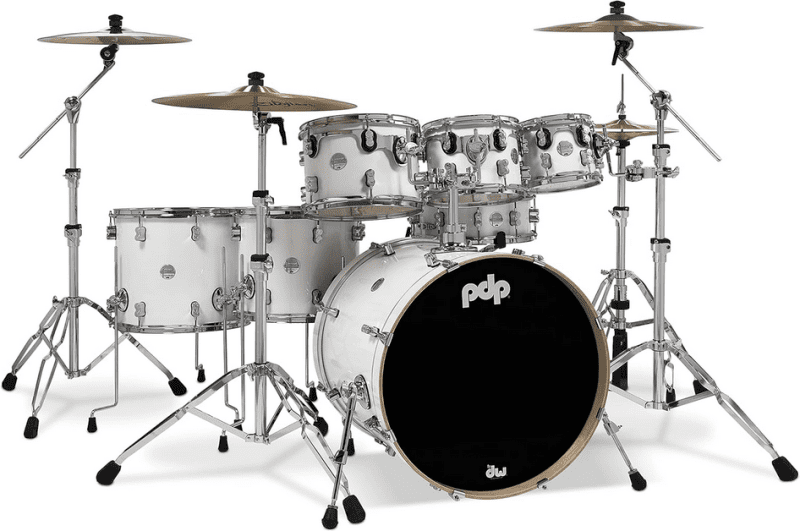Drumming has been used for centuries in various cultures as a form of expression and healing. Today, it's gaining recognition as a powerful therapeutic tool. Drumming can reduce stress, improve mood, and boost overall well-being by engaging both the mind and body in a rhythmic experience.

The simple act of hitting a drum can have profound effects on mental health. It provides a way to release emotions, focus the mind, and create a sense of connection with others. Many people find that drumming helps them feel more relaxed and centered, even after a short session.
Drumming isn't just good for the mind - it also offers physical benefits. The repetitive motions can improve coordination and provide a low-impact workout. Some studies suggest that drumming may even help boost the immune system and reduce pain in certain conditions.
Key Takeaways
- Drumming reduces stress and improves mood through rhythmic engagement
- This practice offers both mental and physical health benefits
- Therapeutic drumming can be used to complement traditional treatments
The Science of Drumming and Healing
Research shows drumming affects the brain and body in measurable ways. Studies have found it can reduce stress, boost immune function, and even impact gene expression.
Understanding the Impact on the Brain
Drumming activates multiple brain regions simultaneously. It engages areas involved in movement, rhythm, and emotion processing.
Brain scans reveal increased activity in the frontal lobes during drumming. This area handles executive functions like focus and emotional control.
The act of drumming also triggers the release of feel-good chemicals in the brain. These include endorphins, which reduce pain and stress.
Studies show drumming can lower cortisol levels. Cortisol is a stress hormone linked to anxiety and depression.
Regular drumming may even promote neuroplasticity. This is the brain's ability to form new neural connections.
Drumming and the Immune System
Research indicates drumming can boost immune system function. One study found it increased the activity of natural killer cells.
These cells help fight viruses and cancer. Participants showed a significant increase in cancer-killing T-cells after drumming sessions.
Another study looked at genomic stress markers. It found that group drumming reduced the expression of genes related to stress response.
This suggests drumming may have effects at the cellular level. It appears to influence how our DNA is read and expressed.
Drumming also seems to increase the production of infection-fighting white blood cells. This could help the body defend against illness.
Mental Health Benefits of Drumming

Drumming offers powerful mental health benefits. It can lift mood, reduce stress, and promote healing from trauma. Many find it helps them feel calmer and more focused.
Combating Depression and Anxiety
Drumming releases feel-good chemicals in the brain like endorphins and dopamine. This can boost mood and ease symptoms of depression. The rhythmic beats also have a calming effect that reduces anxiety.
Group drumming creates social connections. This fights loneliness and isolation that often come with depression. The physical activity of drumming also increases energy and motivation.
Studies show drumming lowers stress hormones like cortisol. It activates both sides of the brain. This balanced brain activity supports emotional regulation.
Drumming as a Tool for PTSD and Trauma
Drumming helps people process difficult emotions tied to trauma. The rhythms provide a safe way to express and release pent-up feelings. Many find it easier than talking about traumatic experiences.
The vibrations and sounds of drums can "unstick" traumatic memories in the body. This allows people to process and integrate these memories in a healthy way. Drumming in groups builds trust and safety for trauma survivors.
Drumming supports the nervous system. It helps regulate the fight-or-flight response common in PTSD. Many report feeling more grounded and present after drumming sessions.
Enhancing Mindfulness and Resilience
Drumming is a form of moving meditation. It trains the mind to focus on the present moment. This builds mindfulness skills that carry over to daily life.
The repetitive beats create a trance-like state. This allows people to access deeper parts of themselves. Many gain new insights about their thoughts and emotions through drumming.
Drumming builds mental toughness. Learning new rhythms takes practice and patience. This grows self-confidence and resilience. Group drumming also teaches teamwork and communication skills.
Regular drumming practice rewires the brain. It creates new neural pathways that support positive thinking. This makes it easier to bounce back from stress and setbacks.
Physical Health Advancements Through Drumming

Drumming offers many physical health benefits. It can help with rehabilitation, improve coordination, and reduce chronic pain. Studies show drumming strengthens muscles and boosts overall well-being.
Drumming in Rehabilitation Settings
Drumming aids recovery for many health conditions. Stroke patients use drum therapy to regain arm movement and dexterity. People with Parkinson's disease practice drumming to improve balance and reduce tremors. Drumming also helps those with autism develop motor skills and focus. Physical therapists use drum exercises to build core strength and endurance in patients. The repetitive motions of drumming promote healing and rewire neural pathways in the brain.
Improving Coordination and Motor Skills
Regular drumming enhances coordination and fine motor control. It requires using both hands and feet in complex patterns. This builds new connections between the brain's left and right hemispheres. Drumming improves timing, rhythm, and hand-eye coordination. These skills transfer to other daily activities. Children who drum show better handwriting and sports performance. Adults gain steadier hands for tasks like typing or playing instruments. Drumming also boosts proprioception - awareness of body positioning. This leads to better posture and fewer injuries.
Social and Emotional Well-Being

Drumming brings people together and helps them express their feelings. It creates bonds between people and allows them to share emotions through music.
Fostering Community and Social Connection
Group drumming builds strong social ties. People of all ages and backgrounds can join in and feel part of something bigger. Drumming circles create a sense of unity and belonging.
In these groups, people learn to work as a team. They must listen to each other and play in sync. This builds trust and understanding between members.
Drumming also breaks down barriers. It doesn't require words, so language differences don't matter. People can connect through the universal language of rhythm.
Drumming for Emotional Well-Being and Self-Expression
Drumming is a powerful tool for emotional release. The act of hitting a drum can help people let go of stress, anger, or sadness. It's a safe way to express strong feelings.
Through drumming, people can explore their emotions. The different rhythms can match how they feel inside. Fast, loud beats might show excitement or frustration. Slow, soft beats could express calm or sadness.
This form of self-expression can lead to self-discovery. As people drum, they may learn new things about themselves. They might find hidden strengths or face fears they didn't know they had.
Drumming can also improve mood. The physical act releases feel-good chemicals in the brain. This can help fight depression and anxiety.
Integrating Drumming into Various Therapeutic Practices
Drumming has found its way into many types of therapy and settings. It brings unique benefits to both clinical and non-clinical environments.
Application in Counseling and Group Therapy
Therapists use drumming in counseling sessions and group therapy. It helps clients express emotions and build connections. In group therapy, shared rhythms create bonds between participants. Drumming also aids people with mental health conditions. It can reduce stress, anxiety, and depression symptoms.
Therapists may use drums alongside talk therapy. The rhythms help clients open up and process feelings. Some counselors have clients drum out their emotions instead of speaking them. This works well for those who struggle to verbalize their thoughts.
Music therapists often include drumming in their work. They use it to improve mood, focus, and social skills. Drumming circles are common in addiction recovery programs. The shared experience promotes unity and supports sobriety goals.
Drumming in Non-Clinical Settings
Outside of therapy offices, drumming has many uses. Companies use drum circles for team building. Employees work together to create rhythms, which boosts teamwork and communication.
Schools add drumming to music classes and after-school programs. It helps students develop focus, coordination, and social skills. Some teachers use short drumming sessions to energize students between lessons.
Community centers offer drumming classes for all ages. These provide stress relief and social connections. Seniors benefit from the physical and mental exercise of drumming.
Drumming plays a role in spiritual and cultural practices. Many groups use drums in ceremonies and rituals. The rhythms help create a sense of unity and purpose. Some people drum as part of meditation or mindfulness routines.
Parks and beaches often host public drum circles. These events let people connect through music in a relaxed setting. They're free and open to all skill levels.
Frequently Asked Questions
Drumming offers numerous benefits for mental and physical health. Research shows it can reduce stress, improve mood, and boost cognitive function.
What are the psychological benefits associated with drumming?
Drumming can lift mood and decrease anxiety. It gives people a way to express emotions without words. Many find it calming and relaxing. Drumming may also boost self-esteem and confidence.
How does participating in a drum circle affect mental health?
Drum circles create social connections. Playing music with others reduces feelings of loneliness. The shared rhythm builds a sense of community. Drum circles can be uplifting and energizing for participants.
Can drumming therapy be used to alleviate symptoms of stress or anxiety?
Yes, drumming therapy can help reduce stress and anxiety. The repetitive motions and sounds are soothing. Focusing on the beat takes your mind off worries. Drumming releases endorphins that promote relaxation.
What are the physiological effects of rhythmic drumming on the human body?
Drumming increases heart rate and blood flow. It can lower blood pressure and boost the immune system. The physical activity releases tension in muscles. Drumming may also reduce chronic pain.
Is there scientific evidence supporting the therapeutic claims of drumming?
Several studies show drumming's positive effects. Research links it to lower cortisol levels and reduced inflammation. Brain scans reveal increased alpha waves during drumming. More studies are still needed to fully understand its impacts.
In what ways does drumming influence cognitive function and brain activity?
Drumming engages multiple brain areas at once. It may improve focus and concentration. Learning rhythms can boost memory skills. Some research suggests drumming could help conditions like ADHD.
DISCLAIMER
This document is provided for general information purposes only and should not be relied upon as providing legal advice, technical, or specific operational guidance to the reader, whether as to the practices described in the document or the applicable legal requirements and regulations. percussionpros.com expressly disclaims any responsibility for liability arising from or related to the use or misuse of any information in this document.




